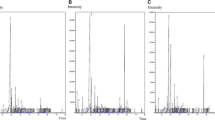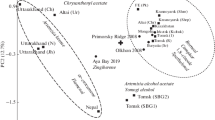Abstract
The essential-oil yield and composition of the aerial parts of Boenninghausenia albiflora were analyzed and compared by capillary GC-FID and GC–MS at different stages of growth and on drying prior to distillation. The essential-oil content of the aerial parts was found to vary from 0.15–0.20 % at different phenophases. Essential-oils were mainly composed of sesquiterpenoids (44.62–52.11 %) and monoterpenoids (25.73–45.95 %). Sesquiterpenoids (44.62–52.11 %) portion of essential-oils was represented by germacrene D (4.18–18.21 %), epi-α-cadinol (0.14–16.25 %), β-caryophyllene (4.62–13.14 %), globulol (0.26–9.22 %), and β-copaene-4α-ol (0.14–7.52 %); while β-myrcene (2.09–26.11 %) and β-pinene (8.36–13.77 %) were the major monoterpenoids. Variations in essential-oil yield (0.15–0.20 %), and contents of monoterpene hydrocarbons (19.38–42.59 %), sesquiterpene hydrocarbons (15.38–36.92 %) and oxygenated sesquiterpenes (9.97–36.73 %) due to different growth stages (vegetative, flowering and seed setting stages) of B. albiflora were noticed. On drying viz. sun and shade drying of the aerial parts of B. albiflora have no drastic influence on essential-ol quality; but significant quantitative variations were noticed. Further, variations in essential-oil composition of leaf and root essential-oils of B. albiflora collected from four different climatic locations were also compared.
Similar content being viewed by others
References
Polunin O, Stainton A (1984) Flowers of the Himalaya. Oxford University Press, New Delhi
Gupta RK (1968) A Hand Book of the flowering plants of Nainital, Flora Nainitalensis. Navyug Publications, New Delhi
Khulbe K, Sati SC (2009) Antibacterial activity of Boenninghausenia albiflora Reichb. (Rutaceae). Afr J Biotech 8:6346–6348
Pande PC, Tewari L, Pandey HC (2007) Ethnoveterinary plants of Uttarakhand—a review. Indian J Trad Know 6:444–458
Wang R, Kong J, Wang D, Lien LL, Lien EJ (2007) Review: a survey of Chinese herbal ingredients with liver protection activities. Chin Med 2:5–12
Chaya N, Terauchi K, Yamagata Y, Kinjo J, Okabe H (2004) Antiproliferative constituents in plants 14: coumarins and acridone alkaloids from Boenninghausenia japonica. Bio Pharm Bull 27:1312–1316
Dixit A, Singh S, Singh NK, Garg GK (2006) Evaluation of genetic diversity and relationships among natural populations of Boenninghausenia albiflora Rchb. ex Meisn. using RAPD profiling. Pl Gen Res Newslett 147:59–63
Sharma R, Negi DS, Shiu WK, Gibbons S (2006) Characterization of an insecticidal coumarin from Boenninghausenia albiflora. Phytother Res 20:607–609
Joshi PC, Mandal S, Das PC, Chatterjee A (1993) Two minor coumarins of Boenninghausenia albiflora. Phytochemistry 32:481–483
Rozsa Z, Szendrei K, Novak I, Reisch J, Minker E (1975) Acridone alkaloids as constituents in the roots of Boenninghausenia albiflora. Pharmazie 30:753–754
Miyazaki T, Mihashi S (1964) Studies on the constituents of Boenninghausenia albifloria Meissner Var. Japonica S. Suzuki. I. Structure of matsukaze-lactone (1). Chem Pharm Bull 12:1232–1235
Talapatra SK, Mukhopadhyay SK, Talapatra B (1975) Minor coumarins of Boenninghausenia albiflora. Phytochemistry 14:836–837
Okamoto T, Kobayashi T, Yoshida S (2005) Chemical aspects of coumarin compounds for the prevention of hepatocellular carcinomas. Curr Med Chem 5:47–51
Yamaha J, Miki S, Murakami H, Maaatsuda H, Fujimura H (1987) Screening test for calcium antagonists in natural products. The active principles of Boenninghausenia albiflora var. japonica. Yakugaku Zasshi 107:823–826
Parihar R, Shah GC, Mathela CS (1991) Constituents of Boenninghausenia albiflora root. Fitoterapia 62:277–278
Suga T, Shishibori T, Kosela S (1975) The neutral volatiles of Boenninghausenia albiflora. Phytochemistry 14:308–309
Padalia RC, Verma RS, Chauhan A, Chanotiya CS (2012) Chemical composition of leaf and root essential oils of Boenninghausenia albiflora Reichb. from northern India. Nat Prod Res 26:2040–2044
Verma RS, Verma RK, Padalia RC, Chauhan A, Singh A, Singh HP (2011) Chemical diversity in the essential oil of Indian Valerian (Valeriana jatamansi Jones). Chem Biodiv 8:1921–1929
Padalia RC, Verma RC, Chauhan A, Chanotiya CS, Yadav A (2011) Variation in the volatile constituents of Artemisia annua var. CIM Arogya during plant ontogeny. Nat Prod Commun 6:239–242
Verma RS, Rahman L, Verma RK, Chanotiya CS, Chauhan A, Yadav A, Yadav AK, Singh A (2010) Changes in the essential oil content and composition of Origanum vulgare L. during annual growth from Kumaon Himalaya. Curr Sci 98:1010–1012
Verma RS, Verma RK, Chauhan A, Yadav AK (2010) Changes in the essential oil composition of Majorana hortensis Moench. cultivated in India during plant ontogeny. J Serb Chem Soc 75:441–447
Adams RP (2007) Identification of essential oil components by gas chromatography/mass spectrometry. Allured Publishing Corporation, Carol Stream
Bisht DS, Padalia RC, Singh L, Pande P, Lal P, Mathela CS (2010) Constituents and antimicrobial activity of six Himalayan Nepeta species. J Serb Chem Soc 75:739–747
Owolabi MS, Ogundajo A, Yusuf KO, Lajide L, Villanueva HE, Tuten JA, Setzer WN (2010) Chemical composition and bioactivity of the essential oil of Chromolaena odorata from Nigeria. Rec Nat Prod 4:72–78
Askari F, Sefidkon F, Teimouri M, Nanaei SY (2009) Chemical composition and antimicrobial activity of the essential oil of Pimpinella puberula (DC.) Boiss. J Agric Sci Tech 11:431–438
Padalia RC, Verma RS, Chauhan A, Chanotiya CS (2013) Changes in aroma profiles of 11 Indian Ocimum taxa during plant ontogeny. Acta Physiol Plant. doi:10.1007/s11738-013-1293-y
Acknowledgments
Authors are thankful to Director, CSIR-Central Institute of Medicinal and Aromatic Plants (CIMAP), Lucknow, Uttar Pradesh for facilities and encouragement; and CSIR for Chem-Bio (BSC-0203) project funding.
Author information
Authors and Affiliations
Corresponding author
Rights and permissions
About this article
Cite this article
Padalia, R.C., Verma, R.S. & Chauhan, A. Compositional Variations in Volatile Constituents of Boenninghausenia albiflora Reichb. from Western Himalaya. Natl. Acad. Sci. Lett. 36, 635–640 (2013). https://doi.org/10.1007/s40009-013-0183-6
Received:
Revised:
Accepted:
Published:
Issue Date:
DOI: https://doi.org/10.1007/s40009-013-0183-6




